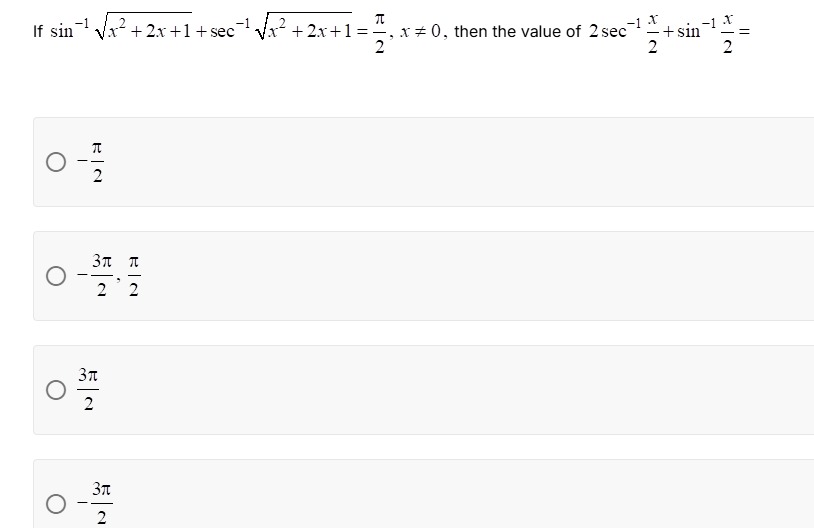Question
Question: If $\sin^{-1}\sqrt{x^2+2x+1} + \sec^{-1}\sqrt{x^2+2x+1} = \frac{\pi}{2}, x \neq 0$, then the value o...
If sin−1x2+2x+1+sec−1x2+2x+1=2π,x=0, then the value of 2sec−12x+sin−12x=

23π
23π
Solution
The given equation is sin−1x2+2x+1+sec−1x2+2x+1=2π.
First, simplify the term inside the square root: x2+2x+1=(x+1)2=∣x+1∣.
Let y=∣x+1∣. The equation becomes sin−1y+sec−1y=2π.
For this equation to be defined, y must be in the intersection of the domains of sin−1 and sec−1.
The domain of sin−1y is [−1,1].
The domain of sec−1y is (−∞,−1]∪[1,∞).
The intersection of these domains is [−1,1]∩((−∞,−1]∪[1,∞))={−1,1}.
So, y must be either −1 or 1.
Since y=∣x+1∣≥0, we must have y=1.
Thus, ∣x+1∣=1.
This gives two possibilities: x+1=1 or x+1=−1.
If x+1=1, then x=0.
If x+1=−1, then x=−2.
The problem states that x=0. Therefore, we must have x=−2.
Now we need to find the value of the expression 2sec−12x+sin−12x for x=−2.
Substitute x=−2 into the expression:
2sec−12−2+sin−12−2=2sec−1(−1)+sin−1(−1).
We need to find the values of sec−1(−1) and sin−1(−1).
For sin−1(−1): The principal value of sin−1z is in the range [−2π,2π]. We are looking for an angle θ∈[−2π,2π] such that sinθ=−1. This angle is θ=−2π. So, sin−1(−1)=−2π.
For sec−1(−1): The principal value of sec−1z is in the range [0,π]∖{2π}. We are looking for an angle ϕ∈[0,π]∖{2π} such that secϕ=−1. Since secϕ=cosϕ1, we have cosϕ1=−1, which means cosϕ=−1. The angle in the range [0,π] with cosϕ=−1 is ϕ=π. So, sec−1(−1)=π.
Now substitute these values into the expression:
2sec−1(−1)+sin−1(−1)=2(π)+(−2π)=2π−2π=24π−π=23π.
The value of the expression is 23π.
